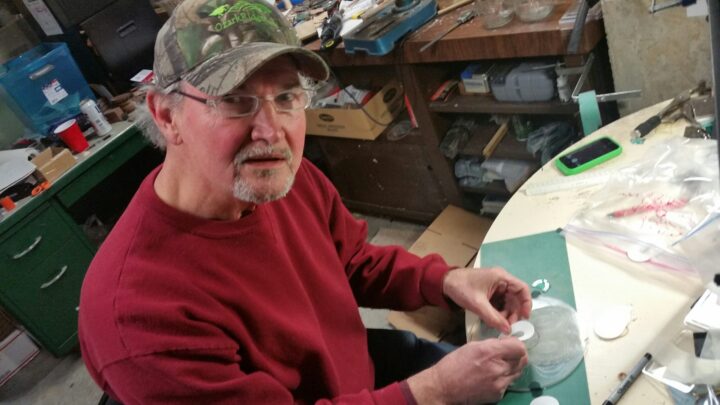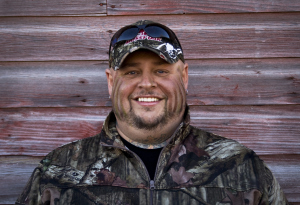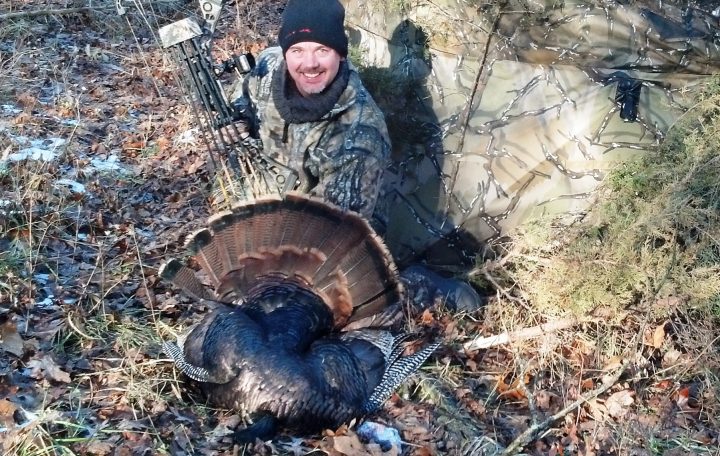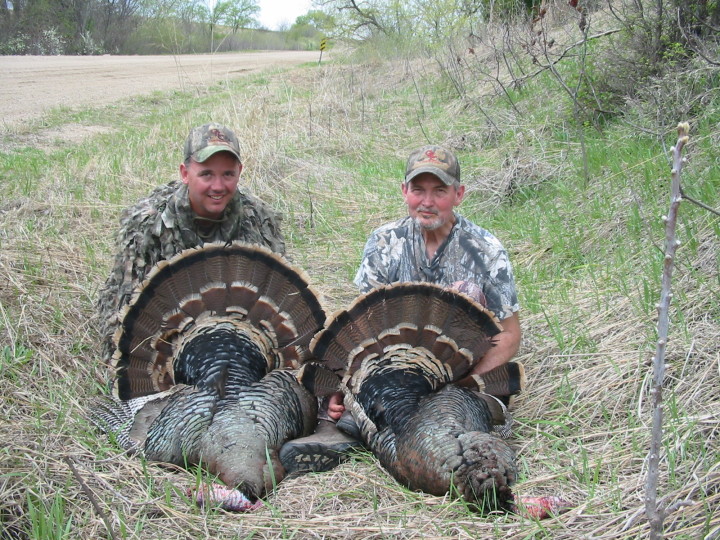Author Archive
Wintertime finds me finalizing all of the hard work I have done throughout the year and putting the final touches on the calls before I put them in a package ready for sale. Mouth calls require cutting and taping. Wooden calls require checking wood grain and checking moisture content before final assembly. I use air dried Missouri Walnut for all of my calls because I feel sound resonates better through the wood when air dried. Once the Ozark Hen box calls and Ozark Ridge push buttons are assembled, I allow a minimum of two weeks drying time before I give them a final tune up before they are sold. For the Ozark Hen box call, I take extra care because due to the characteristics of wood, some just won’t make the sound I’m looking for and I won’t let them out the door until they pass my inspection. I will change paddles until I get the sound I want. I really focus on getting that perfect musical rasp on all my wooden calls. The True Hen Raspy Slate call requires the most tuning and involves calling on each call and matching the call with the perfect striker. Very slight variations in weight and configuration of each striker make each one unique; and we match the perfect striker with each call. I always sand the slate in the sweet spot so they are ready to take to the woods as soon as the package is opened. Usually a slate call takes about 3 weeks to completely cure after it is glued. In addition to perfect musical rasp and tone, my slates don’t echo or squeak like many of other slate calls. I also do sound checks by recording and listening to them in the woods and hunting scenarios. Well you can see I am very busy guy in the winter getting ready for the rush of spring selling season and I just wanted to remind all of our customers and friends how seriously I take this business. I’m proud of this company and proud to make some of the best sounding turkey calls on the market today. Thank you for your business and I look forward to making you a call this season.
Billy Green
By LEONARD CUTBIRTH
After around eleven years of turkey hunting I decided I wanted to see just how my turkey calling would match up with other callers. It’d been very good to me in woods for all those years, maybe I’d do well against others in competition. That’s where the road began and I was in my early twenties so I was full of confidence and competitive spirit.
I started out by joining the N.W.T.F which helped me find contests all over my home state of Missouri. From there I started travelling every weekend to a new town to compete and grow a little better each week as I gained experience. The biggest kicker and downfall for me in competition calling was, is and always will be my nerves. Some callers I’ve talked with have never had any issues with their nerves getting to them. Unfortunately I’ve felt that sickening, nervous effect at every contest I’ve competed in from the smallest, when I first started, to the Grand Nationals I just called in February of this year. If you can beat the nerves you’ll have an advantage in competition.
After spending a while calling in smaller contests and having success on that level, I decided to work toward calling in the bigger competitions. A great thing to have on your side while competing, and getting some wins in your column, is sponsors. If you get to that level, start out by going to the maker of your calls and asking them if you can represent them in competition. Also sporting goods stores in your area can help you out also.
When I first saw Ozark Ridge Calls they were suggested to me by a hunter at a calling seminar I was putting on at local outdoor store. The store had sponsored me when I travelled by paying my entry fees. In return for them helping me I offered to put on seminars and a great relationship was made. After the seminar I purchased several of the calls and tried them out after returning home. I immediately knew that Billy Greens calls were what I wanted to use in competition. I contacted him and we called together at a contest in central Missouri. I’ve been using Ozark Ridge calls ever since for hunting and competing. I’ve called in 3 World Championship Open and Gobbling divisions, U.S. Open Gobbling Division taking 2nd place and 3 Grand National Gobbling Championships. I’ve called in more competitions that I can count and it’s been a blast. I’ve met great friends and wouldn’t change a thing. Even with all the roller coaster rides, nerves being shot, time consumed and money spent.
The best advice I can give to someone starting out would be to practice a lot, call in as many contests as possible and never give up. If you’re not for sure where you might stand in competition get on YouTube and watch a few contest. Best wishes for many contest wins!
As most of us continue to trudge through the winter months, the end of January has me thinking about turkey season and some tips I want to share with our customers, friends and followers. If you can find a quiet place out of a throws reach of those that don’t revere the sound of turkey calling, winter is a great time to hone your calling skills. I especially like to practice my soft calling like purring, tree yelps, putts clucks and purrs, as well as, try to improve the more difficult calls like long series yelps, cutting and cackling. I know for me when I have a gobbler in close trying to call on a slate, my hands can get a little shaky and it is really difficult to hold on to the striker. With a mouth call, my tongue sometimes doesn’t seem to want to move right. Practice the flutter that makes the purr and the soft air flows that are required for tree yelps. Strive to find some real turkey sounds on the internet or from hunting shows and get yourself into correct rhythm as well. Real turkey rhythm is half the battle. In coming weeks before season, we are going to put some Youtube links and recordings on our website to help you with the important work of matching the rhythm of the wild turkey. With a little practice in the winter, the calls will seem easier in the spring, and your new Ozark Ridge Calls will be broken in and ready to go. I recommend some type of recorder to record the sounds you make which puts a little pressure on you to do it right, and you can then listen to yourself. Sometimes you might be surprised that you sound differently on the recording than you sound behind the call. With a mouth call never take a deep breath to make a sound. Just take in enough air to make that sound. Too much air will many times come out strained or out of pitch . A good way to practice is to run as many yelps in a row as you can without stopping, and then yelp the same way as softly as you can; then do a purr as long as you possibly can. Again use just enough air to make the sound; try to call as if you were talking. With a slate call, watch how tight you grip the striker and the call body. Never push very hard with the striker to make soft sounds. Now with the mouth call again do lots of yelps in a row and continues purring both loudly and then very softly. Now get your tape recorder and imagine you have a gobbler at 50 yards and you need to move him closer for a shot. Get a basic double or triple reeded call like the Ozark Ridge Pro ll Sweet and make several soft purrs then do the same thing with your True Hen Raspy Slate and listen to the sounds after you completed a purring, putting and yelping series. This spring when you have that big ole gobbler in close and you need to move him, you will be glad you practiced in the off season and it will give you the confidence to do those soft sounds of the wild turkey hen. Good luck in your winter practice and look for more helpful tips form Ozark Ridge as season approaches.
All our best
ORC
Mar 07
Ozark Ridge Top 5 List
I do not read as much as I should these days, but one thing that always catches my eye are top 5 or 10 lists for hunting and fishing tips. Just like hunting big whitetails where everything seems to only come together with a little luck, I tend to subscribe to the theory that luck is the crossroads of good skills and opportunity. Doing the right thing at the right time is crucial to success in anything we do. So here is my shot at a top 5 list for turkey hunting strategies. These are not cheesy little tips that we all know, these are serious strategies that will work if you use them. I’m not going to waste your attention by telling you how much experience I have or how many turkeys I’ve taken, but I will tell you that I genuinely care about sharing a little of my 30 years of turkey hunting and calling experience gained in both casual and professional settings on both public and private land. I’ll add a few more top 5 or 10 lists and expand on these as the season approaches. Some will grow in complexity a bit as we get closer to season.
Know the Terrain and use it: What would seem universally understood by all hunters is still worth mentioning, even when you don’t know the property that your hunting very well, it is important to have a general understanding of the terrain. You want to attempt to be up-ridge or above your target bird. The only exception would be in relatively flat areas, a pin-down situation with a bird that gets too close or surprises you, or with the bird in a well patterned roost to field situation. Flat featureless topography can be tough, but give me a few hills, hollers, and better yet, a dry creek bed about 6 feet one inch deep and I will be a serious contender for positioning myself for success. More on specific tips on how to move discussed below and in future blogs, but at a minimum take a walk now through your turkey woods or check the GPS or topo maps at a minimum before you get in the woods. Positioning is second only to effective calling and sometimes more important on 3 year old and older turf dragging long beards. When to move and when not to move: If there is one thing I have been more frustrated with in guide and novice friend trips in the past is the complete lack of understanding of the perception of the slightest movement that the brain of a turkey can process as danger. The turkey is not a smart animal, but their little head is the most tightly compacted bundle of instincts known to man. The phrase “if turkeys could smell us like deer, we’d never see one” is simply a fact. Don’t move. Adopt a Hunger Games level game attitude when you are in your hunting or calling position, and if that spot doesn’t work, make like a tree and stay there motionless for another 15 minutes, then get up and move if you need to. This becomes more important in situation where the bird has shut up. If he has answered your call and shuts up, he is either coming, going or strutting around his girl. I tend to lean toward the – he’s coming mindset until he sounds off again. Try to stay put and DON’T MOVE until you hear him gobble again, then make a move decision. Calling is communicating – know what you are saying: One of the biggest challenges to turkey hunting is learning how to make the basic sounds made by the hen turkey. I’ve seen a lot of good turkey callers who knew how to call at turkeys, but knew little about communicating. Most callers over do the cutting, cackling and all the hyped excited hen stuff and forget that there are some basic communications that all turkeys have known since the nest. We will talk about mating yelps, cuts, putts purrs and the 10 other calls we don’t have space for right now, but know this now: Every gobbler in the woods knows one call above all others and without exception; the one call that means COME TO ME, NOW. This same call has perhaps saved the bird’s life from daily predator threats and other dangers as simple as loosing track of mom and siblings. The ASSEMBLY CALL is the call the hen uses to gather the flock from birth. It is also the call she uses to call her mate. If you effectively use it at the right time, they will come. Assembly Call Call enough but not too much: As the stick hit me square on top of the head from behind as I showed off my future Grand National calling skills for my father at 12 years old, I realized as I turned around that dad wasn’t happy with me. Learning later after nearly blowing the reeds out of the Ozark Ridge Pro V on the first setup. Dad said you froze him in the tree – you called too much, froze him in the tree, and the hen roosted behind us flew down, made her way around us and the gobbler flew down only after he saw the real hen. Lesson learned, and it has served me well since. I will expand on this later, but two to three soft tree yelps and a putt or two when the bird is topside and answering strongly – then you need to shut up. I don’t care if he gobbles 29 more times in the tree. Don’t fall in the answer every gobble or two trap, especially if he is in the tree. He’s got no better vantage point than his tree and he is content to stay right there if you talk too much. Hunt a little longer: As a kid in my public hunting land days, I loved my 7:45 nap in the timber. Sometimes after starting up birds for other hunters that spooked them; or worse yet those guys that move in on your setup thinking they are between a hen and a hot gobbler effectively cutting you off and usually spooking or shooting the bird headed your way. My alarm clock was their trucks starting and heading to the coffee shop to tell stories about their big hunt. Turkeys are like roosters in the morning. They gobble because they are glad to see the sun rise and warm them up. Morning light also means safety after a long night listening to things that want to eat them crawl through the leaves all night. What makes a bird gobble at 6:00 a.m. is not what makes a turkey gobble at 8 or 9. This may sound arrogant, but let’s call it experienced confidence- I will kill most birds that answer my call after 8 a.m. By 8 or 8:30 he has had breakfast, he’s strutted around, he’s warmed up and if he answers me, it’s not just because that giant light bulb is coming over the horizon. He’s answering me because I have communicated something that means come to me and he is communicating back that he understands. As I said earlier, he’s coming until you know that he’s going, DON’T MOVE, and get ready.Good luck this season my friends; more next week.
Ozark Ridge Calls
We are very proud to bring you our new Ozark Ridge Calls website and finally get a little better connected in the social network scene. We are going to do our best to bring you the high quality communication in this forum that you find in our custom calls. Our goal is to share our experiences, including our successes and the lessons all good turkey hunters learn each year. I’m committed to posting often with timely information on calling and hunting wild turkey; and I think I’ll start by telling you a little about our business. Ozark Ridge Calls began in 1989 by my father, Billy Green, in his home workshop. Dad is still building calls one at a time in that same workshop. We have learned some important things about calls and calling over the past 24 years in this business. One of them is that every call is different; and to make calls that are truly better you have to assemble the various components by hand and listen to what is being made. We never sell a friction call without testing it. We find that one striker that sounds great on one call, may not work well on another. One wood type, surface angle or component on the push button call might not work on the box call. 24 years of making calls has taught us that hand tuning our friction calls and continually refining the stretch, reed alignment and signature cuts in our mouth calls ensure the quality that we demand and that our customers want. Stay tuned, and until next time drop us an email with questions or hot topics. Thanks for visiting our site!!!




